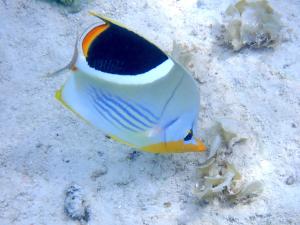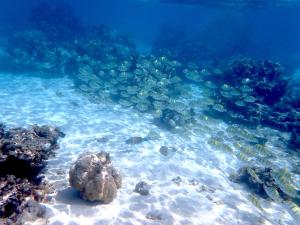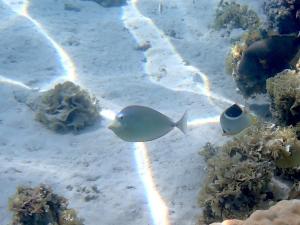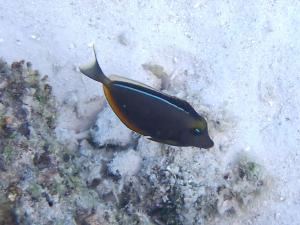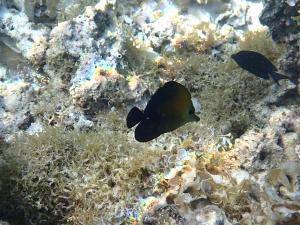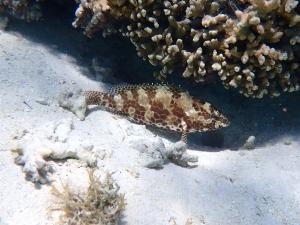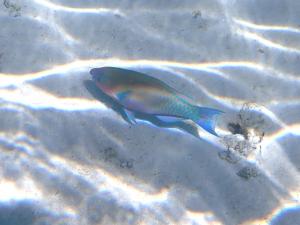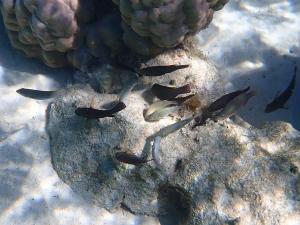
Hilton Moorea
Hilton Moorea Lagoon Resort and Spa. A Hilton Resort.
BP 1005, PAPETOAI, 98702, French Polynesia.
Coordinates in degrees decimal: 17.48444 S, 149.843889 W.
Visited in February 2021. Photographer: Nigel Thomas. Cameras: Olympus Tough T6.
Website: https://www.hilton.com/en/hotels/pptmlhi-hilton-moorea-lagoon-resort-and-spa/
Overview.
The Hilton Moorea Lagoon Resort and Spa is located on the north coast of Moorea, in French Polynesia. The resort is 30 minutes from the Moorea ferry port, which can be accessed from Papeete on the main island of Tahiti.
The resort faces north into the Moorea Lagoon. It features a chain of overwater bungalows, each with individual access to the sea. The sea areas around the piers and off the beach support a variety of shallow water habitats (<3m), with the principal type comprising coral heads (0.3m to 3m diameter), resting on a generally flat sandy seabed. Care needs to be taken while snorkelling due to the shallow water nature of the corals, which can be easily kicked inadvertently.
The sand in many cases is very thin and overlays rock and moribund coral, which supports numerous small burrows. The coral heads are generally in good condition, but several have died leaving rock formations with many hollows and overhangs. Most of the coral heads coexist with Turbinaria algae in the shallower waters. The sand areas may appear to be lifeless but numerous fish species occupy the burrows, and these can be observed with a bit of patience.
Fish life overall is varied and often abundant. Seventy species of fish were identified with a further 60 invertebrate and other species observed. Unfortunately, local spearfishermen visit the area regularly and few large individuals of the common species, such as Parrotfish, can be observed.
Climate and sea conditions
Winds are generally from the ENE to ESE with the prevailing wind coming from the east. The winds are rarely over 12 knots, mostly staying below 9 knots. Periodic squally winds occur, with the strongest winds occurring between July and September. Winds from the westerly to southerly quadrant are rare. Water temperatures range from 25 to 28 Celsius, with the lowest in August and the highest between January and April. Atmospheric temperatures are fairly uniform, with mean daily maximums between 26 and 29 Celsius. Warmest months are December to May.
Max tidal range is in the order of 30cm, which in general does not create any strong currents in the lagoon, however, the continuous heavy surge created by the waves breaking on the outer reef edge, results in periodically moderate currents in the lagoon. These appear to be in an easterly direction in the inshore waters and westerly in the outer lagoon areas. Use the current to your advantage by swimming against or across the flow initially and then drifting with the current.
Visibility appears to be uniformly clear, up to 15m in the lagoon, despite the sporadic nature of the rain. Heavy rain, however, may occur with strong squally winds, which reduces visibility and makes snorkelling uncomfortable. Heaviest rainfall period is between December and February with minimum rain between July and September.
Vessel activity is minimal as most operate in identified channels further offshore. An open sea access channel exists to the west of the resort, originating from the diving hut jetty on the shore. Fast moving, sports canoes, also cross the area so keep your head up occasionally.
Completed without the support of the resort.
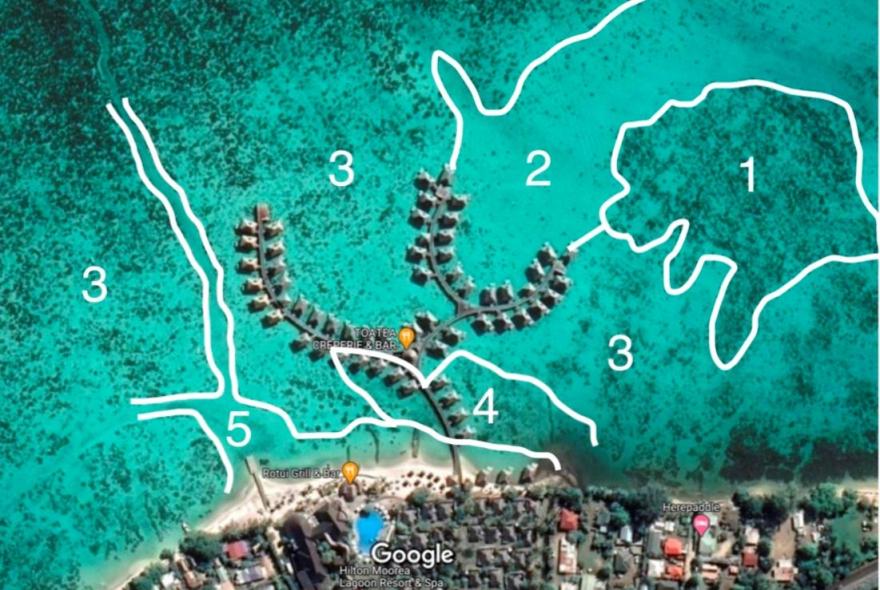
Area 1. To the east of the resort with high density coral heads. Area 2. To the north-east of the resort. Large expanses of sand in relatively deep water. Area 3. Sporadic coral heads within extensive areas of sand. The density of coral increasing further offshore. Area 4. Inshore, where the bungalow jetties start. Sporadic corals but mixed with sand and coral debris and a seabed covering of Patina and other algae, frequent burrows. Area 5. Generally shallow water sands, in some cases the layer of sand is thin, and the underlying rock is exposed. Frequent burrows. Area 6. Not mapped but the areas beneath the jetties create a shaded habitat favoured by several fish species.
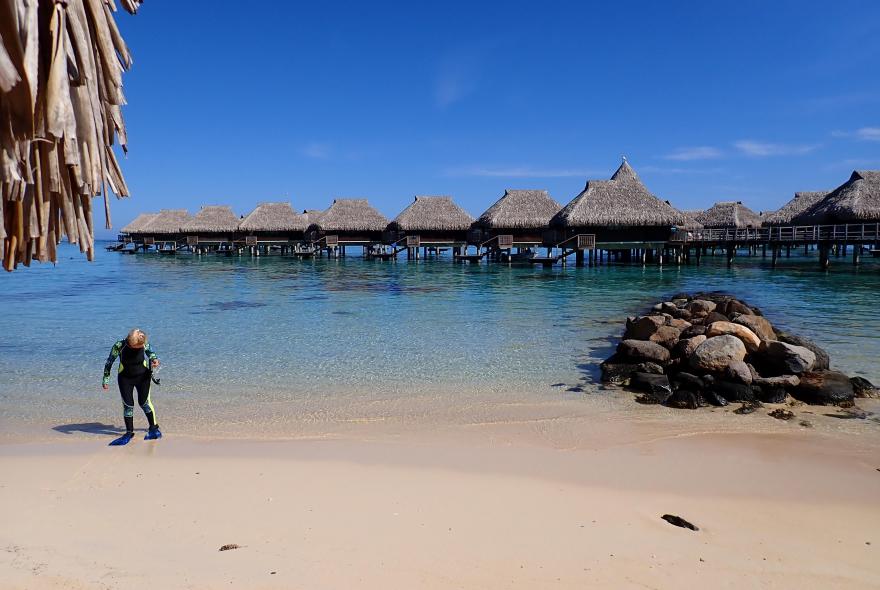
Entry off the beach is easy and gives access to the low density coral heads (area 3) mixed sand and coral debris (area 4) and the shallow water sands (5). Several manmade rock breakwaters may be found here, which support collections of Sergeant Majors as well as a sizable Giant Moray Eel.
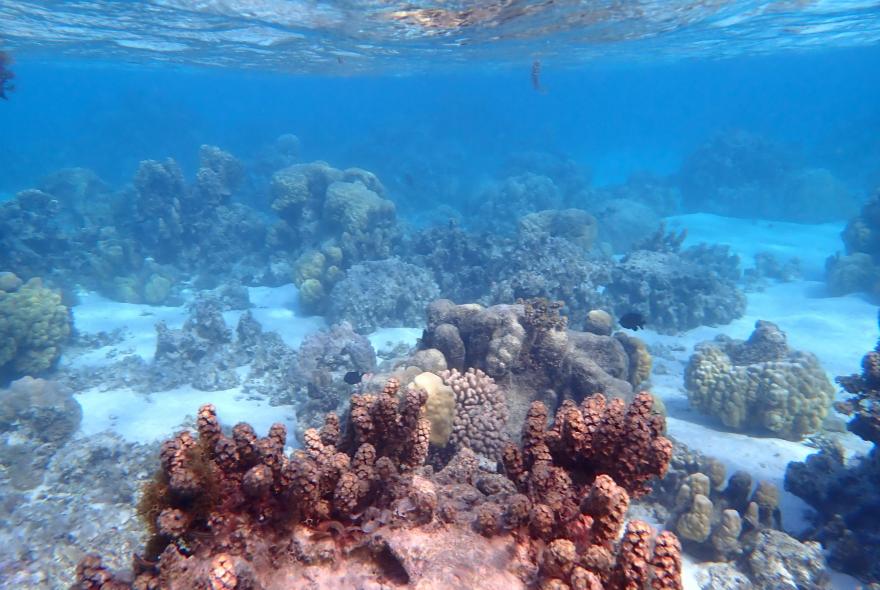
Area 1. Typical aggregation of coral heads in about 2m of water.
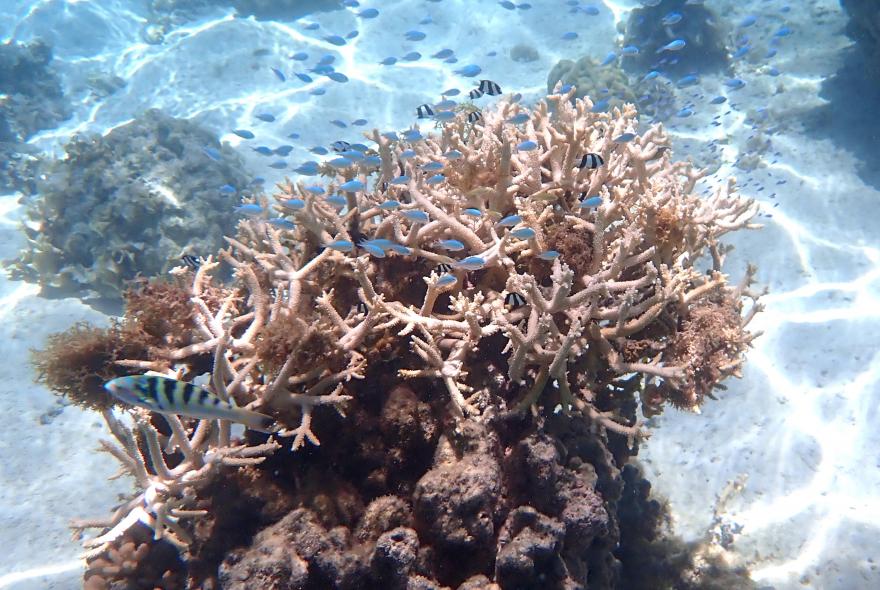
Coral species are varied in area 1, with good examples of delicate Acropora species present. These corals are often home to shoals of small fish species, particularly Chromis.
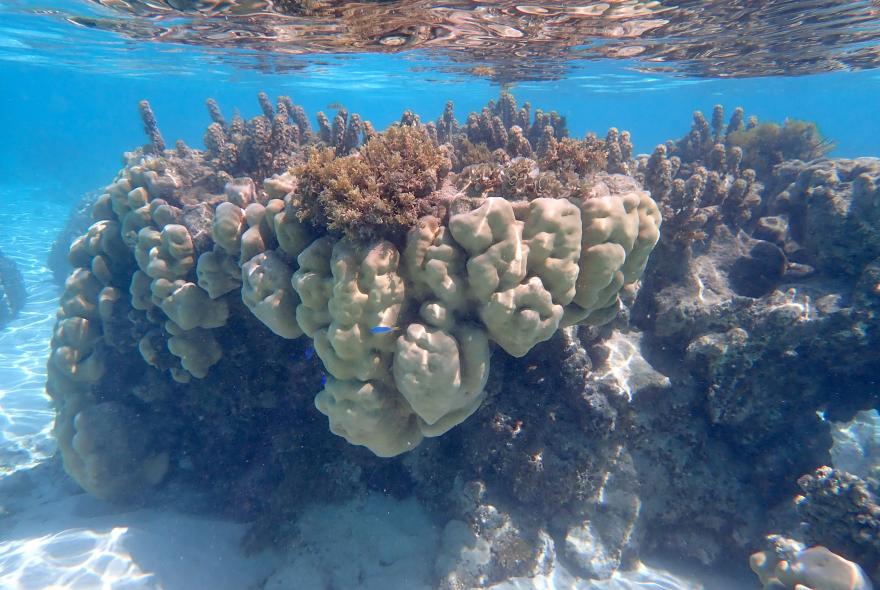
A good example of a coral head (Porites sp.) in coexistence with the shallow water algae Turbinaria. Areas 1 and 3.
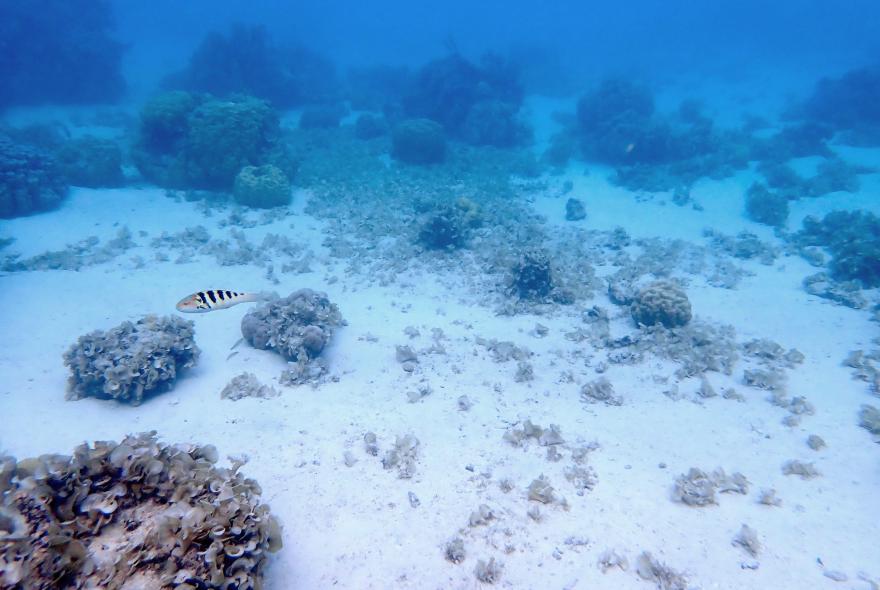
Area 4. Padina alga covering the seabed between sporadic coral heads. Many burrows noted in this area.
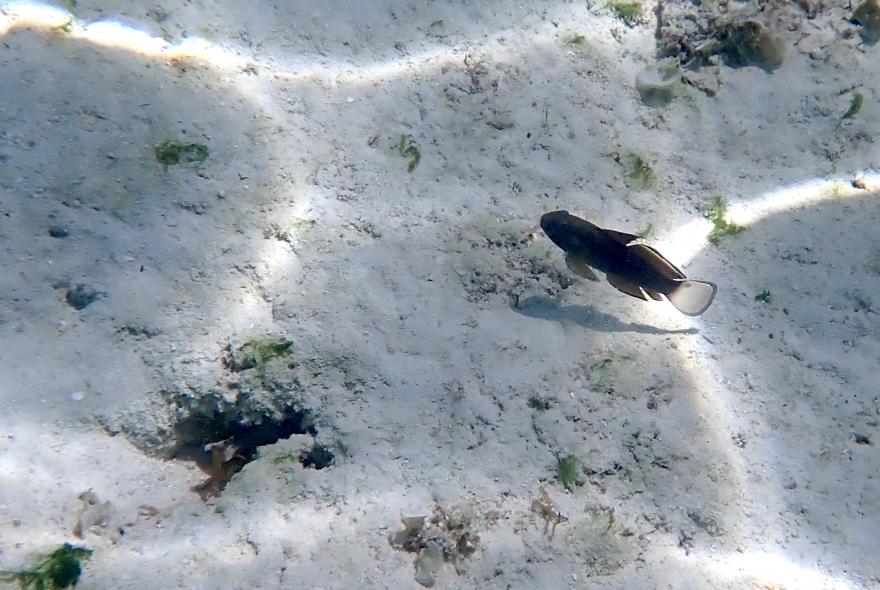
Burrows are a feature of the sand habitats (areas 2 and 5) and the algal and sand covered subsurface rock (area 4). Example of a Banded Goby found in area 4.
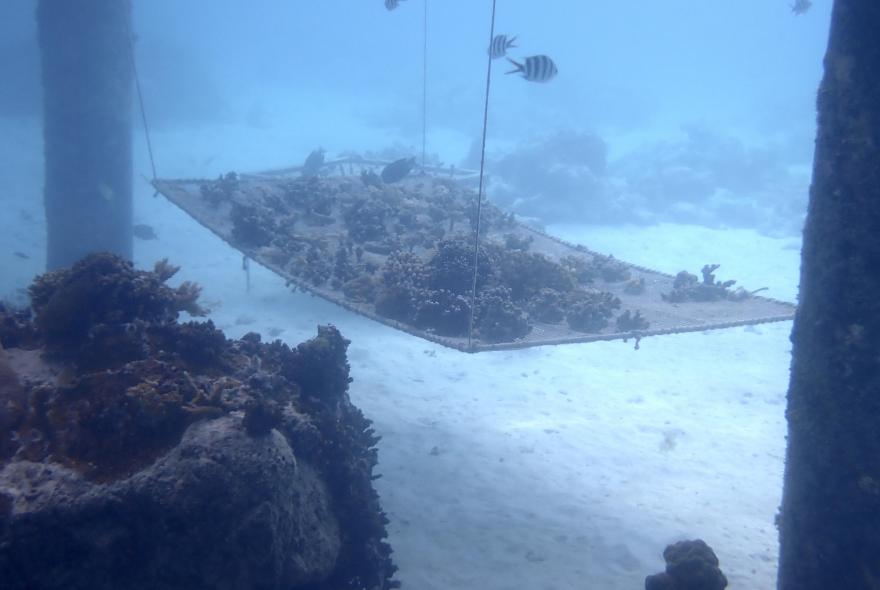
Coral regrowth project (https://coralgardeners.org/) located under the jetty near the creperie. Please don’t touch.
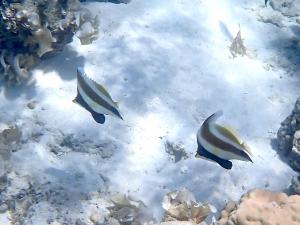
087. Pennant Bannerfish. Chaetodontidae. Heniochus chrysostomus. Nearly always noted in pairs. Areas 1 and 3.
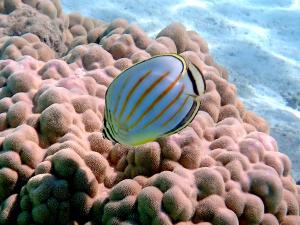
Ornate Butterflyfish. Chaetodontidae. Chaetodon ornatissimus. Frequently found in pairs, noted particularly over corals in area 1.
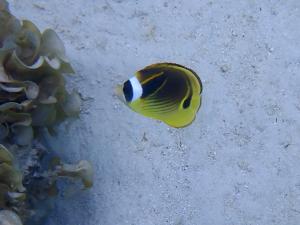
Racoon Butterflyfish. Chaetodontidae. Chaetodon lunula. Juvenile noted in the vicinity of coral heads. Areas 1 and 3.
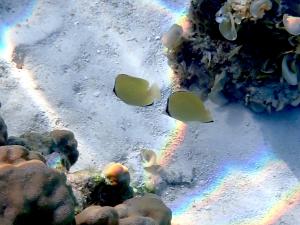
Speckled Butterflyfish. Chaetodontidae. Chaetodon citrinellus. Always in pairs over and amongst healthy coral, areas 1 and 3.
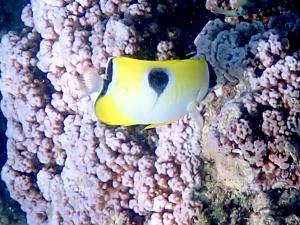
Teardrop Butterflyfish. Chaetodontidae. Chaetodon unimaculata. Solitary or small groups, areas 1 and 3.
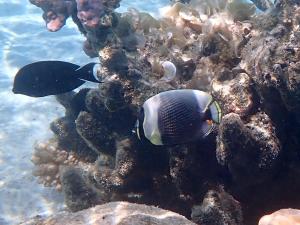
Reticulated Butterflyfish. Chaetodontidae. Chaetodon reticulatus. Solitary or in pairs over coral in areas 1 and 3.
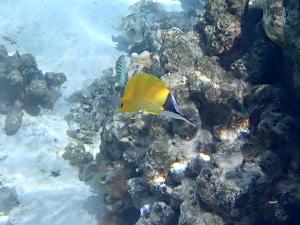
A little fuzzy but probably a Longnose Butterflyfish. Chaetodontidae. Forcipiger flavissimus. Solitary or in pairs, infrequently noted in area 1.
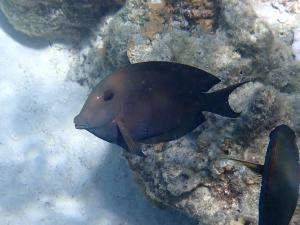
Striated Surgeonfish. Acanthuridae. Ctenochaetus striatus. One of the most common fish in the area. All areas with coral heads. Avoid contact.
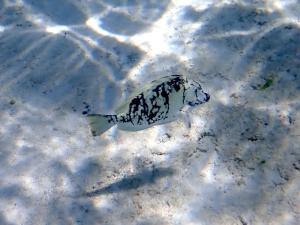
Unusual aberrant colour form of surgeonfish, probably a Convict Surgeonfish. Acanthuridae. Acanthurus triostegus. A couple of examples noted over areas 4 and 5.
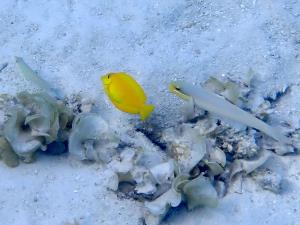
Juvenile of the Orangespot Surgeonfish. Acanthuridae. Acanthurus olivaceus. Frequently noted in areas 1 and 3. In this instance, however, in the company of a Bluestreak Goby. Gobidae. Valencienna strigata in area 5.
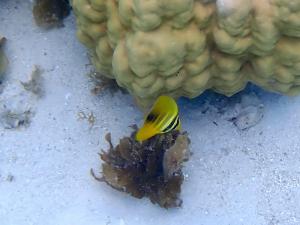
A juvenile of, probably, a Pacific Sailfin Tang. Acanthuridae. Zebrasoma velifer. Noted around live coral heads, area 1.
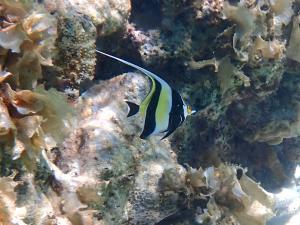
Characteristic long dorsal fin identifies the Moorish Idol. Zanclidae. Zanclus comutus. Frequent all areas with coral heads, including areas 1, 3 and occasionally 4.
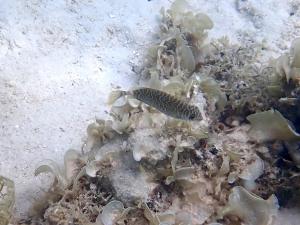
Juvenile of a Scribbled Rabbitfish. Siganidae. Siganus spinus. Small individual noted in shallow waters of area 4.
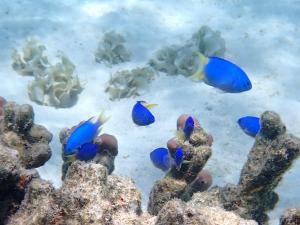
Small group of a dark blue Damsel. Pomacentridae. Pomacentrus ?coelestis. Noted in shoals around and amongst living and dead coral. Areas 1 and 3.
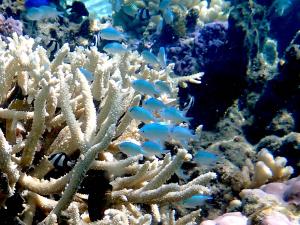
Light blue coloured Blue Damsel. Pomacentridae. Pomatocentrus pavo. Common amongst the branches of Acropora and other branching coral, Area 1.
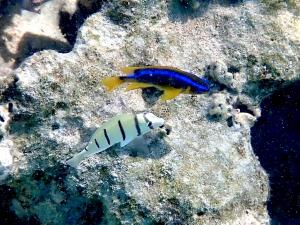
Upper species is a Surge Damsel. Pomacentridae. Chrysiptera sp. Lower is a juvenile Convict Surgeonfish. Acanthuridae. Acanthurus triostegus. Noted amongst live and moribund coral, areas 1 and 3.
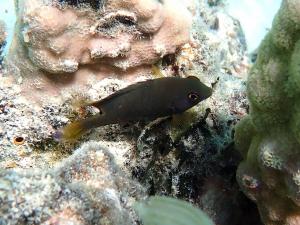
Black spot on tail base suggests Threespot Damsel. Pomacentridae. Pomacentrus tripunctatus. Numerous over all dead reef, highly territorial. Areas 1 and 3.
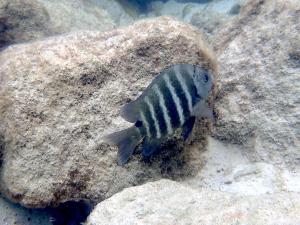
Vertical stripes and black spot at base of tail identifies this as a Blackspot Sergeant. Pomacentridae. Abudefduf sordidus. Common in shallowest waters around, breakwaters and under jetty. Area 4.
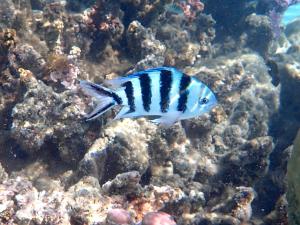
Scissortail Sergeant. Pomacentridae. Abudefduf sexfasciatus. Common in the inshore areas and under the jetty. Area 4.
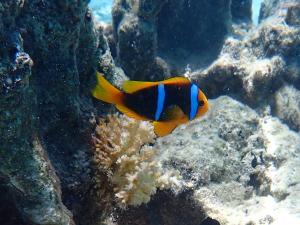
Orange-tail variant of the Orangefin Anemonefish. Pomacentridae. Amphiprion chrysopterus. Noted in anemones on the outer edge of area 1.
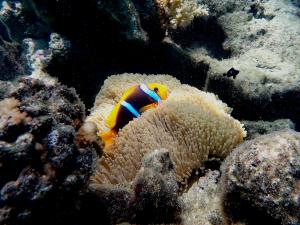
Orangefin Anemonefish. Pomacentridae. Amphiprion chrysopterus. Image showing host anemone, Magnificent Sea Anemone. Actinaria. Heteractis magnifica.
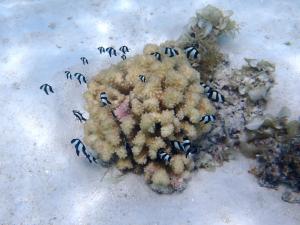
Shoal of Humbug Dascyllus. Pomacentridae. Dascyllus aruanus. Always associated with a branching coral. Often large shoals. Areas 1 and 3.
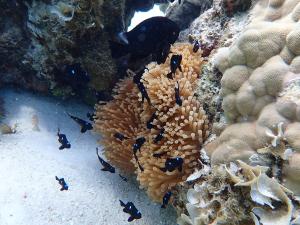
Threespot Dascyllus. Pomacentridae. Dascyllus trimaculatus. Distribution limited to the presence of the Magnificent Sea Anemone. Actinaria. Heteractis magnifica. Outer edge area 1.
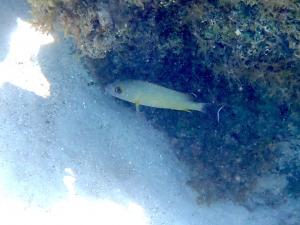
Not the clearest image but distinct yellow behind the eye and white fringe on brown/black tail of the Blacktail Snapper. Lutjanidae. Lutjanus fulvus. Noted at base of coral heads in hollows and under overhangs. Area 1.
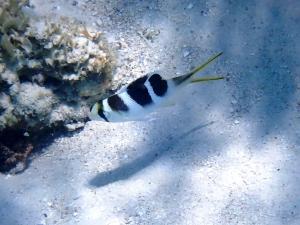
Sub-adult of Redfin Bream. Lethrinidae. Monotaxis heterodon. Solitary around the base of coral heads. Often appears to be immobile.
